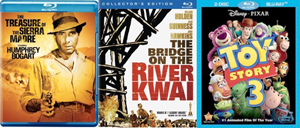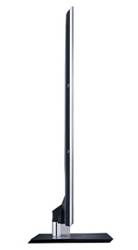Introduction
During the HD-DVD vs. Blu-ray format war, Toshiba was the main supporter of HD-DVD and producer of hardware. Beyond being just an HD-DVD player, their units were well known for being high quality standard DVD players with very good up conversion of legacy titles. After taking a bit of a break following the demise of HD-DVD, Toshiba is now back with a full line of Blu-ray players. I took a look at the BDX-2700, their highest end 2D model.
Specifications
- Design: Blu-ray Player
- Supported Formats: BD-Rom, DVD-ROM, DVD-R DVD+R, CD, CD-R/RW.
- Supported Audio: Internal Dolby Digital Plus, Dolby TrueHD, and DTS Master Audio Decoding, Bitstream Support for Dolby TrueHD and DTS-HD Master Audio
- Supported Video Resolutions from HDMI: 480i, 480p, 1080i, 1080p60, 1080p24
- Streaming Features: Blockbuster, Vudu, Netflix, Pandora
- Dimensions: 2.5″ H x 16.9” W x 8.3” D
- Weight: 3.7 Pounds
- MSRP: $220 USA
- Toshiba
Design and Setup
The 2700 has a few hardware and software features to help distinguish it from the rest of the Blu-ray players on the market: 7.1 analog outputs and WiFi are included on the hardware side, which are both very nice features to see. The 2700 will decode all of the new audio codecs for the 7.1 output if you need that, though it only supports a global crossover frequency for all your speakers. The 2700 is lacking any internal memory for BD Live support, which means you’ll need to take advantage of the SD card slot on the front of the machine. With Profile 2.0 having been established for over two years now, there really is no reason for any player to not include at least a minimum of 1 GB of memory to support it. Physically the 2700 is very light and has a very shallow chassis that makes it easy to move around and fit into tight spaces, but does not feel really solid.
On the software side, the streaming media support that Toshiba includes is Vudu, Netflix, Blockbuster and Pandora. The Netflix interface is quite nice and lets you browse the entire library of streaming titles, instead of restricting you to selecting from your Instant Queue as many other players do. The speed of navigation on it was pretty decent as well. Vudu has a nice library of high definition movies you can download and watch, many in 1080p with Dolby Digital Plus audio. While I didn’t pay for any movies, I did watch a few of the movie trailers in this HDX format, and they were possibly the best streaming content that I’ve seen to date on a Blu-ray player. I’ve never been a big fan of paying to stream movies because of how they look on a large TV, but the HDX content from Vudu could make me reconsider that. Pandora worked just fine as well in my quick use of it and I don’t have a Blockbuster account to try it out. There’s no other streaming content available, such as YouTube, Flickr, Picasa, or DLNA support. The 2700 also supports playback of media files from the SD card slot on the front of the machine.
Setup of the 2700 was very easy as I just plugged in an HDMI and Ethernet cable to the back and was ready to go. I later changed from Ethernet to WiFi as I used the player in my bedroom and after the initial setup, I didn’t have any issues with the connection. The menu system of the 2700 is a little strange, with 3 main choices: BD-ROM, Settings, and Connected. Selecting BD-ROM will load the movie in the tray, Settings will bring up your configuration options, and Connected will bring up the streaming options. The animation flipping through these options and then bring up the sub menus is a bit slower than I would like, and I wish I could disable it to speed up the system. Additionally, with only 3 options under connected, it seems they could have made a single menu with all the options available at once to speed it up.
Settings contained the most common options that you would see for a player, including output resolution, film mode, Deep Color support, and bitstreaming or PCM for audio support. There were no options to change the deinterlacing of the player (many players offer Auto, Film, or Video selections) or to change the format of the color output (The 2700 outputs x.v. Color, not RGB or YUV formats, over HDMI). This is not something that every player offers, or most people care about, but it’s a nice option to have.
In Use
Unfortunately, the first thing I noticed about the 2700 in use is that it is very slow to start up the compared to most current players. The speed reminded me of the Pioneer models from two years ago and was far behind the current players from Oppo or Sony that I use on a regular basis. However, once the movie loaded the image was very nice and worked well at 60p or 24p over HDMI. Watching Toy Story 3, the picture was incredibly detailed with colors that popped, and a soundtrack that took you into the film. I never noticed a single artifact during the film, either in the transfer or from the Toshiba, and highly enjoyed the experience.

Moving onto a more classic film, Bridge on the River Kwai looked better than I had ever seen it before. The warm, rich hues of the Technicolor print really came through, with lots of detail and fine film grain. The Toshiba did just as well with black and white film. The Treasure of the Sierra Madre was recently released with a new transfer for Blu-ray and looks absolutely superb. Shadow detail and contrast in the film are excellent, and the fine detail in scenes is remarkable for a film of this age. Every Blu-ray title that I played came through just fine, and with remarkable clarity.
One issue did happen with some titles when I would stop playing them, though. In my testing I’d often return to the main menu to change settings, as none of the main settings (resolution, deep color, bitstreaming audio) can be changed on-the-fly. Multiple times when I would do this, the Toshiba would lock up and I’d have to hold down the power button on the front for a few seconds to reset it. It never happened during a movie, but it happened fairly often when I’d stop one to go to the menu, and looking around the forums makes it sound like this happens to others as well. I hope it’s just a small bug that Toshiba can fix with a firmware update in the future.
Using the online services was quite easy. Netflix was much easier to navigate than on my Sony or TiVo, giving me access to the whole library and not forcing us to just use my instant queue to select something to watch. The quality was quite good as well, with it buffering fairly fast and not having pauses during pans or any other content that we watched. Vudu worked quite well as I mentioned earlier, and went from being a feature that I hadn’t cared about to something that I can easily see myself using more and more in the future. The HDX films were pushing the limits of my cable modem connection however, but bandwidth should keep increasing in the future rendering this issue moot. The remote that ships with the Toshiba worked fine, though it’s not backlit and using it in the dark was a challenge.
Finally, there were a couple more issues that I ran into with the player in general use. A few times, if I went a couple of days without using the player, it would just refuse to power on. Once I unplugged the power and plugged it back in the problem was gone, but it would happen again later as well. I thought this might be something in my system causing this, but research showed that other people have run into this same bug. Additionally, the Open/Close button on the front of my review unit would often register a single press as a double press, causing it to open and close instantly, restarting the film. This was more an annoyance, and since review units can go to many different reviewers and really get abused quickly, I’m not sure if it’s unique to this unit, or a common problem. Finally, I had an issue when I first hooked it up to a receiver on review that the receiver was only reporting to the Toshiba that it supported 1080i for a maximum resolution and not 1080p, so I was unable to select it on the Toshiba. Given that EDID information reported by displays is often wrong, I wish that Toshiba would give you the option to overrule this and select whatever resolution you wanted, as you can always go back to the composite connection to fix this. I got around it by hooking it straight up to my display for setup, and it worked fine after that.
On The Bench
The Toshiba did very well on the bench, except for noise reduction and the component video testing at 1080i. Over component the levels seemed to rise and fall continuously when viewed on the scope, therefore those test results have been omitted as they are unreliable. Checking with my reference Oppo confirmed that the scope worked correctly, but the signal level from the Toshiba seemed odd. I didn’t notice anything when watching video over component, though the vast majority of my watching was done over HDMI and component was only used for viewing bench tests. The layer change was almost imperceptible on DVDs, though the loading time for the player overall was very slow.
Conclusion
The Toshiba BDX-2700 did remarkably well on the bench, other than a couple of video tests where it had issues locking onto patterns moving vertically instead of horizontally. It also offers wireless connectivity, 7.1 analog audio outputs, and good streaming content from Netflix and Vudu. However, it also is slower than other players out there on the market now, missing some other streaming options that many players now have, and has quite a few bugs that I have no idea when, or if, they will be resolved. When I first received the unit, I considered purchasing it for my Dad as he was in need of a player, doesn’t have HDMI on his receiver, and uses Netflix for streaming so it seemed like a good combination. However, after the issues that I encountered, I didn’t want to deal with having to support this when something might go wrong.
With its features and image quality, I think Toshiba is on the right path with their Blu-ray lineup. However, I think the model I tested has some bugs that need to be fixed for it to be an enjoyable user experience Nothing stopped me from being able to fully use and test it, but it caused some headaches for me during that time. If Toshiba can resolve these issues, then this is a player I can recommend for people that need the combination of features that it offers, but if they can’t then I fear it might wind up being a frustrating experience for the user.








